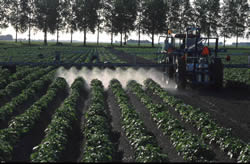
A new form of potato blight widely found in Europe (namely the A2 mating type) could become established in the UK according to a leading potato blight researcher, speaking at British Potato 2005.
Dr Huub Schepers is a plant pathologist for PPO Lelystad in the Netherlands and also chairman of the European network for integrated potato blight control. He warned growers attending a breakfast seminar hosted by crop protection company Certis at the event, that although for the moment the UK has escaped infestation of this new form of blight (Phytophthora infestans), quick establishment in a new territory is possible.
Same symptoms
"While this form of blight exhibits the same symptoms and will be controlled with the same forms of chemistry that UK growers are familiar with, it can result in an altogether more virulent disease," he said.
Dr Schepers explained that instead of just the A1 mating types, this new blight also has A2 isolates that probably originated from Mexico. During the sexual phase of the P.infestans life cycle a form of potato blight results that exhibits greater variability and therefore increased opportunity for adaptation. "The pathogen grows faster between infection and expression of symptoms, the spores have higher levels of infection and fewer hours of leaf wetness are necessary to instigate the disease. The result is that control is more difficult" Furthermore, he pointed out that adaptation to the weather conditions means survival at the higher and lower extremes of temperature.
With important implications for blight control programmes, Dr Schepers advocates careful selection of fungicide treatments to match the product and the type of activity according to the optimum crop stage for control. He also welcomes greater choice of treatments that offer extra systemic, kickback and translaminar activity. For the rapid growth phase of the season he said that Valbon (benthiavalicarb + mancozeb), new in the UK for the 2006 season, fits this need as part of a programmed approach.
Treatment intervals
However, he noted that a reliance on scheduled treatment intervals could be very dangerous. "A seven-day spray schedule may have reduced control after day four, and with this aggressive new blight population, with three more days before the next fungicide spray could be too late."
Instead, he said that decision support systems and early notification tools that alert growers to conditions conducive to disease should be used alongside individual assessment of the weather conditions and knowledge of inoculum present in the field and surrounding area. Dr Schepers also stressed the importance of reducing primary inoculum sources such as potato dumps and volunteers.
